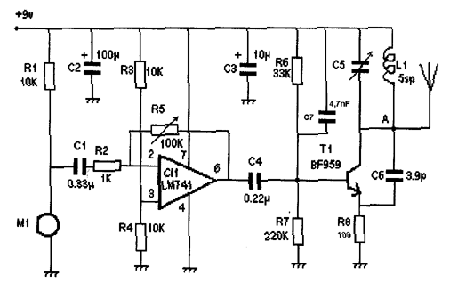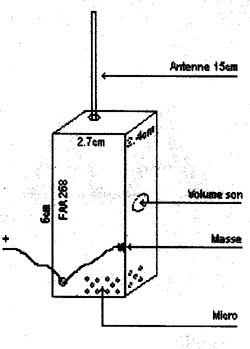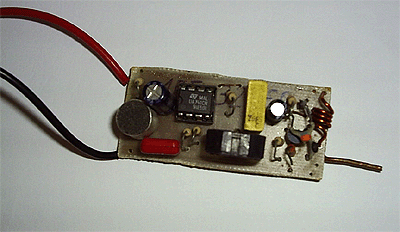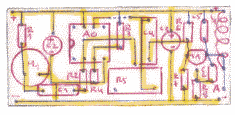The experimental FM transmitter, designed to operate within the frequency range reserved for radio broadcasting stations between 88 MHz and 108 MHz, is a fascinating device primarily used for educational purposes. This type of transmitter provides a valuable opportunity to explore the principles of Frequency Modulation (FM) and understand how audio signals are transmitted through radio waves. It allows technology enthusiasts and electronics students to delve into the world of broadcasting and communications engineering.
The experimental FM transmitter is often employed in educational settings, such as school and university laboratories, to illustrate both theoretical and practical concepts of FM modulation. By demonstrating how variations in the frequency of an audio signal can be translated into radio waves, it offers a practical and engaging learning experience.
It is important to note that while the use of this transmitter can be educational, it must be done in compliance with local broadcasting regulations. Proper permissions must be obtained if one intends to broadcast signals in the FM band, and it is essential to adhere to applicable laws to prevent unwanted interference with existing radio stations. Therefore, while exploring the educational aspects of this experimental FM transmitter, it is also crucial to promote responsibility and compliance with broadcasting rules to maintain an orderly and harmonious radio environment.
Electronic diagram

List of components
1/4w resistors
R1: 10k
R2: 1K
R3: 10K
R5: adjustable 100K
R6: 33K
R7: 220K
R8: 100
Capacitors
C1: 0,33mF
C2: 100mF/16v
C3: 10mF/16v
C4: 0,22mF
C5: choose for example 15pf (The frequency is 102Mhz)
C6: 3,9pF
Miscellaneous
T1: Transistor BF959
CI1: LM741 or TL071
M1: Electret microphone
L1: Self 5 turns
Box
You can build a small metal box to house the card.

Map layout of components
Key Notes
1. Capacitor C7 should be soldered on the copper side as indicated in the schematic.
2. Resistor R7 stabilizes the transmitter’s frequency.
3. Increasing the transmitter’s voltage decreases the frequency.
4. Increasing the value of C6 decreases the frequency.
5. An antenna tuned to the collector of transistor T1 (point A) lowers the frequency.
6. The LM741 amplifier can be replaced with the TL071.
Additional information
BF959
The BF959 is a bipolar junction transistor (BJT) distinguished by its valuable technical characteristics for radiofrequency (RF) and amplification applications. This transistor is designed to operate in the High-Frequency (HF) range, making it an optimal choice for radio applications and RF amplification circuits. The BF959 can handle frequencies up to several hundred megahertz (MHz) and offers high input impedance and rapid switching capability. It is often used in the input stages of radio receivers, RF amplifiers, and other circuits requiring high sensitivity to high-frequency signals. With its reliability and high performance in the high-frequency range, the BF959 is a preferred choice for electronic engineers working on projects requiring precise and stable RF amplification and reception.
LM741
The LM741 is an operational amplifier (op-amp) widely used in electronics for decades. Its technical characteristics make it valuable for many applications. The LM741 is powered by direct current and typically operates with a single supply voltage, usually between ±5V and ±18V. It offers a wide range of gain, up to 200,000, making it suitable for amplifying weak signals. Its typical bandwidth is around 1 MHz, making it suitable for low-frequency applications. It has high input impedance and low output impedance, facilitating integration into various configurations. Furthermore, the LM741 is known for its thermal stability and low drift, ensuring reliable performance across a wide range of conditions. In summary, the LM741 is a versatile and robust electronic component widely used in analog electronics for amplifying, filtering, and processing a variety of signals.
TL071
The TL071 is an operational amplifier (op-amp) commonly used in electronics for a variety of applications. Notable technical characteristics include a single-supply voltage, typically between ±5V and ±18V, making it compatible with a wide range of systems. The TL071 offers a wide bandwidth, typically reaching 3 MHz, making it suitable for medium and high-frequency applications. It has a high input impedance, meaning it presents minimal load on input signals, and a low output impedance, allowing easy connection to other components. Additionally, the TL071 is known for its thermal stability and low drift, ensuring consistent performance in different temperature conditions. This versatile op-amp is widely used in electronic circuits for amplification, filtering, and signal processing, making it an essential component in many applications.

